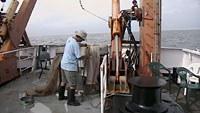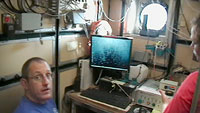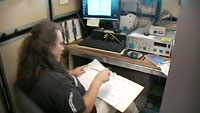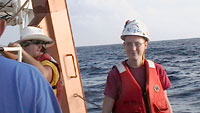

 | |||||||||||||||||||
|
|
Journals 2009/2010David Wehunt
August 23, 2009 Latitude: N 39° 59' 94" Today was a day of surprises, some good and some not so good. I woke a little before 1 am, went out on deck and looked at the southern shore of Long Island, New York. We were on station, taking plankton samples about a mile offshore. We were near I think, the spot where my brother Joseph, who lives with his family on Long Island, showed me as a great place to fish. When we left we headed out to sea southeast and then we turned northeast towards Georges Bank. I woke up to begin my day with 16 foot swells. Naturally, I felt fine when I woke up but soon began to feel ill. I wasn't real bad but I wasn't close to all right. I did however do my assignments. The good news was that Hurricane Bill was past and quickly leaving the area and so the swells would get lower after awhile. The first station seemed to go smoothly but a problem developed with the cable on the back deck so while it was being repaired we would use the front winch and A-frame. However the winch had problems and so we couldn't use the front winch either. So we steamed to our next station 5 hours away and Will and Ed went to work on the cable problem which they had fixed and ready to go with 30 minutes to spare. So the day was very quiet and by the time I had to work again I was feeling MUCH better. Sights seen today: Fishing boat setting long lines for sword fish, two container ships, two pods of dolphins (one in morning and one in evening) and a spouting which was a whale but I never saw the whale. Now as promised the team I am working with. Jerry, from Narragansett, Rhode Island, is the chief scientist on the boat and is an Oceanographer. Jerry likes to SCUBA dive and photography. He has been leading this research trip for a number of years and has even had one of his children participate on one of the trips. Jerry works the day shift as I do. Next is Jon, an Oceanographer, also from Narragansett (born in Rochester, New York). Jon oversees the Ecosystem Monitoring Project which is what we are supporting by collecting samples on this cruise. This study has been ongoing in one form or another since the mid 70s. Besides oceanography, Jon also likes to study fisheries. Jon works the night sifts from 5pm to 6 am. Then there is Tamara our computer expert, from woods Hole, Massachusetts and works for NOAA Fisheries' Woods Hole lab. Tamara is a Physical Science Technician and she is responsible for data auditing. Tamara was a last minute addition to this expedition and keeps the computer programs working right which is critical since the data collected is very important. However Tamara likes to get out on the deck and do the dirty work like collecting samples out of the plankton nets like the rest of us. Tamara works the day shift. Finally there is Alison, the graduate student from the University of Rhode Island's Graduate School of Oceanography. Alison is from California and is really interested in plankton and using genetics to answer questions about ecology. Alison also has an interest in krill and understanding what is krill's source of food. Alison is the other member of the night shift.
As I have been writing this journal the swells have increased in size and have been striking us starboard abeam (broadside from the right) and a 9 footer just threw everything over. What a mess. Well, bye for now. Student Question: What is the difference, if any, between an ocean swell and a wave? |
||||||||||||||||||



